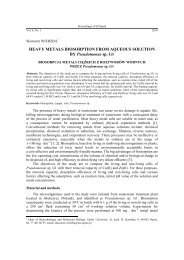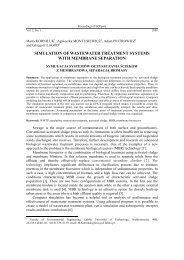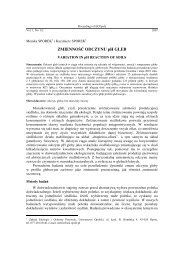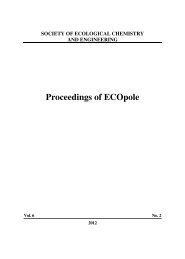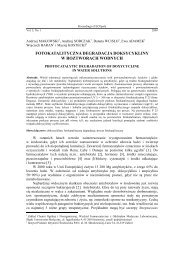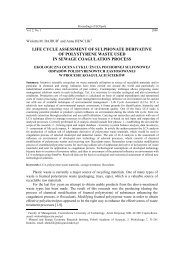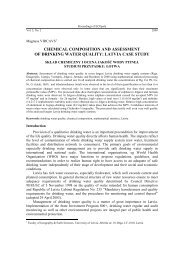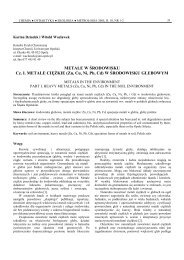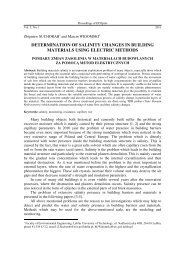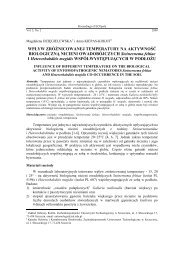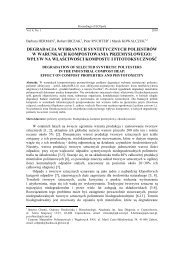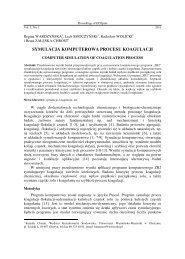Download part 3 of the issue - Uniwersytet Opolski
Download part 3 of the issue - Uniwersytet Opolski
Download part 3 of the issue - Uniwersytet Opolski
You also want an ePaper? Increase the reach of your titles
YUMPU automatically turns print PDFs into web optimized ePapers that Google loves.
324<br />
Jarosław Gawdzik i Jolanta Latosińska<br />
sumarycznej zawartość metali ciężkich w badanych osadach ściekowych. Informacja ta<br />
jest pomocna przy ocenie zdolności migracji metali z osadów ściekowych do<br />
środowiska gruntowo-wodnego.<br />
• Otrzymane wyniki pozwalają stwierdzić, że udział frakcji niemobilnych (frakcje III<br />
i IV) metali ciężkich w badanych osadach ściekowych jest dominujący.<br />
• Wykazano istotną korelację pomiędzy wielkością oczyszczalni ścieków<br />
a mobilnością metali ciężkich dla obiektów o RLM ≤ 50 000.<br />
Literatura<br />
[1] ‘Alvarez EA, Mochón MC, Jiménze Sánchez JC, Rrodríguez MT. Heavy metal extractable forms in sludge<br />
form wastewater treatment plants. Chemosphere. 2002;47:765-775.<br />
[2] Chen M, Li X, Yang Q, Zeng G, Zhang Y, Liao D, Liu J, HU J, Guo L. Total concentration and speciation<br />
<strong>of</strong> heavy metals in sewage sludge from Changasha, Zhuzhou and Xiangtan in middle - south region <strong>of</strong> China.<br />
J Hazard Mater. 2008;160:324-329.<br />
[3] Dahlin CL, Williamson CA, Collins WK, Dahlin DC. Sequential extraction versus comprehensive<br />
characterization <strong>of</strong> heavy metal species in brownfield soils. Environ Foren. 2002;3:191-201.<br />
[4] Fytili D, Zabaniotou A. Utilization <strong>of</strong> sewage sludge in UE application <strong>of</strong> old and new methods - A review.<br />
Renewable and Sustainable Energy Rev. 2008;12:116-140.<br />
[5] Ryu HW, Moon HS, Lee EY, Cho KS, Choi H. Leaching characteristics <strong>of</strong> heavy metals from sewage sludge<br />
by Acidithiobacillus thiooxidans MET. J Environ Quality. 2003;32:751-759.<br />
[6] Weiner RF, Mat<strong>the</strong>ws RA. Environmential Engineering. Burlington: Elsevier Science; 2003.<br />
[7] Xiang L, Chan LC, Wong JWC. Removal <strong>of</strong> heavy metals from anaerobically digested sewage sludge by<br />
isolated indigenous iron-oxidizing bacteria. Chemosphere. 2000;41:283-287.<br />
[8] Strawn DG, Sparks DL. Effects <strong>of</strong> soil organic matter on <strong>the</strong> kinetics and mechanisms <strong>of</strong> Pb (II) sorption and<br />
desorption in soil. Soil Sci Am J. 2000;64:144-156.<br />
[9] De la Guardia M, Morales-Rubio A. Modern strategies for <strong>the</strong> rapid determination <strong>of</strong> metals in sewage<br />
sludge, Trends in Anal Chem. 1996;15(8):311-318.<br />
[10] Krogmann U, Boyles LS, Bamka WJ, Chaiprapat S, Martel CJ. Biosolids and sludge management, Water<br />
Environ Res. 1999;71(5):692-714.<br />
[11] Gruca-Królikowska S, Wacławek W. Metals in <strong>the</strong> environment <strong>part</strong> II. Effect <strong>of</strong> heavy metals on plants.<br />
Chem Dydakt Ekol Metrol. 2006;11(1-2):41-56.<br />
ANALYSIS OF HEAVY METALS MOBILITY IN MUNICIPAL SEWAGE<br />
SLUDGE FROM DIFFERENT CAPACITY SEWAGE TREATMENT PLANTS<br />
Civil Engineering and Environmental Protection De<strong>part</strong>ment, Kielce University <strong>of</strong> Technology<br />
Abstract: The article presents <strong>the</strong> results <strong>of</strong> heavy metal mobility research. The methodology used in <strong>the</strong> research<br />
was suggested by <strong>the</strong> Community Bureau <strong>of</strong> Reference (BCR). The examined sludge was supplied by five<br />
municipal sewage treatment plants (from central Poland) <strong>of</strong> different capacity and methods <strong>of</strong> sewage sludge<br />
stabilization. It was proved that heavy metals were present mainly in immobile sludge fractions without any<br />
significance for a toxicological aspect. The capacity <strong>of</strong> sewage treatment plants demonstrate an explicit influence<br />
on <strong>the</strong> forms <strong>of</strong> heavy metals present in BCR fractions. A hypo<strong>the</strong>sis was formulated that copper forms in sewage<br />
sludge are <strong>the</strong> characteristic feature <strong>of</strong> this chemical element. The percentage contribution <strong>of</strong> zinc, lead, cadmium,<br />
nickel and chromium in BCR fractions obtained using <strong>the</strong> method <strong>of</strong> sewage sludge extraction did not depend<br />
significantly on <strong>the</strong> method <strong>of</strong> sludge stabilization.<br />
Keywords: sewage sludge, heavy metal, sequential extraction, HMs mobility



